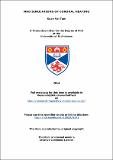Files in this item
MHD simulations of coronal heating
Item metadata
| dc.contributor.advisor | Hood, Alan W. | |
| dc.contributor.author | Tam, Kuan V. | |
| dc.coverage.spatial | 145 | en_US |
| dc.date.accessioned | 2015-03-27T09:55:03Z | |
| dc.date.available | 2015-03-27T09:55:03Z | |
| dc.date.issued | 2014-12-01 | |
| dc.identifier | uk.bl.ethos.644823 | |
| dc.identifier.uri | https://hdl.handle.net/10023/6373 | |
| dc.description.abstract | The problem of heating the solar corona requires the conversion of magnetic energy into thermal energy. Presently, there are two promising mechanisms for heating the solar corona: wave heating and nanoflare heating. In this thesis, we consider nanoflare heating only. Previous modelling has shown that the kink instability can trigger energy release and heating in large scale loops, as the field rapidly relaxes to a lower energy state under the Taylor relaxation theory. Two distinct experiments were developed to understand the coronal heating problem: the avalanche effect within a multiple loop system, and the importance of thermal conduction and optically thin radiation during the evolution of the kinked-unstable coronal magnetic field. The first experiment showed that a kink-unstable thread can also destabilise nearby threads under some conditions. The second experiment showed that the inclusion of thermal conduction and optically thin radiation causes significant change to the internal energy of the coronal loop. After the initial instability occurs, there is continual heating throughout the relaxation process. Our simulation results show that the data is consistent with observation values, and the relaxation process can take over 200 seconds to reach the final relaxed state. The inclusion of both effects perhaps provides a more realistic and rapid heating experiment compared to previous investigations. | en_US |
| dc.language.iso | en | en_US |
| dc.publisher | University of St Andrews | |
| dc.rights | Creative Commons Attribution-NonCommercial-NoDerivatives 4.0 International | |
| dc.rights.uri | http://creativecommons.org/licenses/by-nc-nd/4.0/ | |
| dc.subject | Magnetohydrodynamic (MHD) | en_US |
| dc.subject | Coronal heating | en_US |
| dc.subject | Nanoflare | en_US |
| dc.subject | Lare3D | en_US |
| dc.subject | Thermal conduction | en_US |
| dc.subject | Optically thin radiation | en_US |
| dc.subject | Kink instability | en_US |
| dc.subject | Avalanche effect | en_US |
| dc.subject.lcc | QB529.T2 | |
| dc.subject.lcsh | Magnetohydrodynamics | en_US |
| dc.subject.lcsh | Thermal conductivity | en_US |
| dc.subject.lcsh | Sun--Corona | en_US |
| dc.title | MHD simulations of coronal heating | en_US |
| dc.type | Thesis | en_US |
| dc.contributor.sponsor | Science and Technology Facilities Council (STFC) | en_US |
| dc.type.qualificationlevel | Doctoral | en_US |
| dc.type.qualificationname | PhD Doctor of Philosophy | en_US |
| dc.publisher.institution | The University of St Andrews | en_US |
This item appears in the following Collection(s)
Except where otherwise noted within the work, this item's licence for re-use is described as Creative Commons Attribution-NonCommercial-NoDerivatives 4.0 International
Items in the St Andrews Research Repository are protected by copyright, with all rights reserved, unless otherwise indicated.


